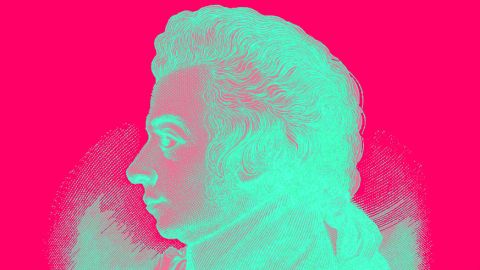Why Mozart Rocks So Hard. Artistic Genius Explained.

Editor’s Note: Over the next 12 days, Big Think will be running excerpts from all the lessons that make up our first online course, Great Big Ideas. During this period, we are offering discounted subscriptions to Big Think readers. You can now subscribe and gift this course for $99. Please sign up and then subscribe using the coupon code THINK to get the discount.
What’s the Big Idea?
What’s the difference between a Jackson Pollock painting and a finger-painting? Why is “The Magic Flute” so enduring, while other classical compositions have been forgotten? Is “I know it when I see it” as close as we’ll get to defining what we mean by “great art”?
These are the questions Leon Botstein, the dean of Bard College, raises in his Floating University lecture, Art Now: Aesthetics Across Music, Painting, and Culture. He illustrates his own perspective with a story about Mozart and his student, Thomas Atwood, a mediocre musician. Watch here:
“One of the important things about what makes a work of art is the power of the human imagination to predict something,” says Botstein. “Although there have been strong traditions of art that are random… most of what we think is art is the result of people thinking about doing something and being carried away by either some plan or some intuition or some imagination.”
The child’s finger painting is distinguishable from a Pollock painting because of its structure, and a Mozart composition is distinguishable from the work of his students’ because of its uniqueness and imagination. In other words, transformative power and intent are the mark of a master.
“Eventually you can look at your own photograph that you took of your friend or your parents or a sibling with your camera in your cell phone and realize it isn’t quite the same as a portrait by Irving Penn or by Diane Arbus. There is something about what they did with the same basic medium that shows you that there is something you might learn, something you might think about.”
What’s the Significance?
Botstein sees art is a social activity in which individuals seek to enter into a conversation across time and space. Geniuses are the experts in their disciplines, those who teach the rest of by example, and with ease. The trouble, of course, is how difficult it is to determine or agree collectively how to evaluate their efforts:
The real debate in the arts is, are there criteria for art that could be persuasive in a democratic society to induce a society to support it? Is there some objective way of saying ‘Well, a Beethoven symphony, a Wagner opera, a Debussy nocturne – those are superior to something else – that certain buildings, certain painters, certain sculptures are understood as critically superior to things that are of the same type, but not as good? Is there a hierarchy of goodness? Is there some true value to our judgments about art? Is it reasonable to say ‘That just isn’t art’ or ‘that’s bad art?'”
Tell us – what do you think? How do you tell whether a work of art is good or bad? Is there a criteria we can use to judge the aesthetic merit of art, or does it all come down to taste?
To subscribe to the Floating University course “Great Big Ideas,” click here.




